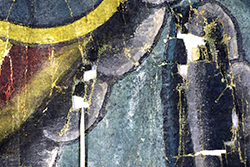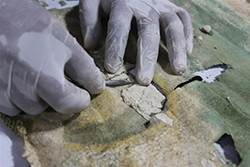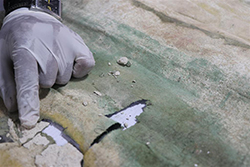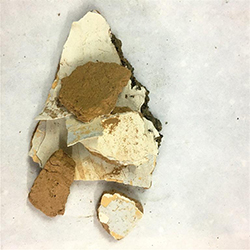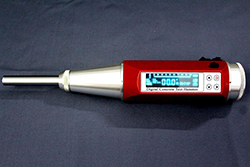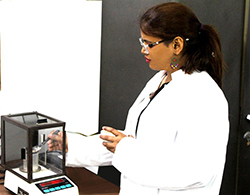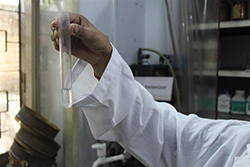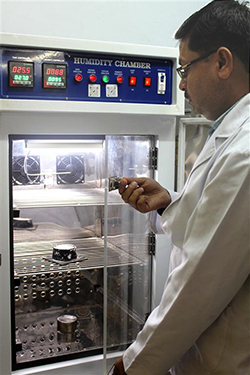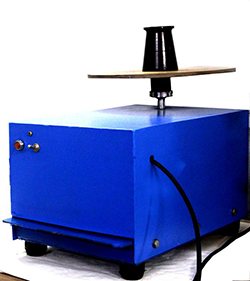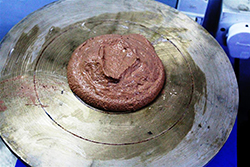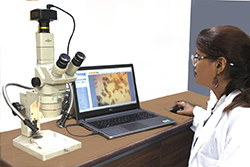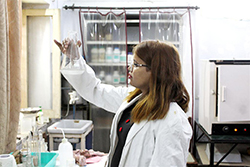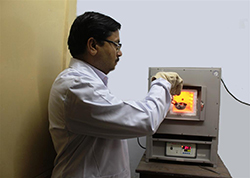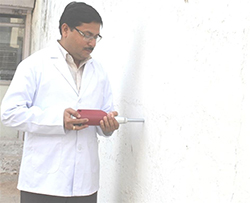Lime Research and Testing Centre
The use of lime in building construction began at least 10,000 years ago, with debated evidence of earlier uses. The focus of academic research to date has been on historical and archaeological use of lime in Europe and the Near East. Traces of lime have been found in some early Egyptian buildings mainly in monuments. The ancient Greeks commonly used lime stucco as external covering for the temple.
Lime has been used in India as construction material from ancient times however, the application has been found to be very limited. A scientific study has been done on Karvan, a well known place of pilgrimage in Gujarat in Western India by R. V. Karanth’, K. Krishnan” and K. T. M. Hegde” in 1986. The site dates to 2nd to 3rd centaury AD, the evidence of lime plaster used, however has been found of 7th centaury AD. John Marshall recorded the use of gypsum at Mohenjo-Daro as a mortar and also as a plaster medium (Marshall, 193 1: 269), but the plaster samples from these structures were not examined to evaluate their quality or analysed scientifically to determine their composition. In Islamic architecture hydraulic lime as mortar and plaster has been used extensively.
Lime was used on occasion in the early period, as evidenced from the deposits of lime plaster lining the ovens and cylindrical pits found within the houses of the site of Kalibangan, Rajasthan (Indira Gandhi National Center for the Arts , 2009). These structures date to the proto-Harappan period, 3500–2500 BC; however, the widespread use of lime in structures is not common until much later as is seen within the structures at the Buddhist settlement of Nagarjuna-Konda, the capital of the Ikshvaku dynasty (225–325 AD) (Ghosh 1990). Lime plaster was more commonly used amongst the early civilizations of India; this plaster contained a lot of sand and clay, which is thought to be indicative of the use of kankar (masses or layers of calcium carbonate found within alluvium and clay). Lime plasters from the city of Kausambi (35–350 AD), in Uttar Pradesh, were found to contain a variety of ratios of sand:lime; these ranged from 1:1 – to 4:3 (Ghosh 1990)
These plasters were not very pure as they contained gypsum, clay and phosphate as well as the sand and lime (Prakash and Rawat 1961). Much of the literature for the architecture of India and Asia relates to the religious buildings of the various faiths. Initially Buddhism was the dominant religion in India; however, as invaders entered the region they brought with them the Islamic faith (Smith 1999). As a result mosques began to appear throughout the country—initially these were in the form of bamboo and thatch huts, but gradually brick buildings became more common, as did the use of a dome and a square floor plan (Kuban
1974). The mosques within the region of Bengal were primarily built within the Restored Ilyas Shahi (1433–1486) and the Husayn Shahi (1493–1538) dynasties and represented a fusion of Bengali and migrant technologies (Hasan 2007).
In India, many monuments built by the Qutb Shahis (1518–1687) in and around the city of Hyderabad often used lime mortar in their construction, as seen at the tomb of Muhammad Qutb Shah (Seshan 2002). The Charminar was built in 1591–1593 by Quali Qutub Shah, the fifth ruler of the Qutub Shahi, and was constructed from granite and lime mortar (Seshan 2002).
Lime mortar can be made by slaking the lime and then leaving it or storing it as putty, instead of adding the aggregate immediately or turning the lime into a dry hydrate (dry hydrated lime powder). The lime putty develops a skin of carbonate, which allows the material to be stored for a long period of time before use. The benefits of storing putty have been argued, but it is considered that the process of maturation increases the plasticity, workability, and water retention of the final product. The use of lime in later India was quite common, and the Western colonialists would have partially influenced its use. The Krishan Mandir temple (built in 1830) in the village of Krishankot in the Punjab used not only lime mortar in its construction but also lime plaster and limewash (Rai and Pandit 2009). Initially the temple was built of burnt bricks placed in a bed of lime mortar and covered in a lime plaster; at a later date a green limewash was added to the external walls (Rai and Pandit 2009)
In traditional Indian buildings ‘surkhi’ or burnt clay and ‘bajri’ (sand) was added with hydraulic lime. In some places hydraulic lime was made by burning argillaceous limestone or ‘Kankar’.
After the development of Portland cement, a new material as a binder in India, decline in the use of lime as a building material started. Over a period of time, many historic and traditional buildings of stone and bricks, which were set in lime based mortar have been repaired with cement which gives disastrous effects on the buildings. Since both materials are chemically different and incompatible.
Before invention of cement, lime mortar was used for building construction material; the properties of lime depend on raw material of lime, burning temperature and slaking process.
Now days heritage conservation professionals are facing problems for selection of lime; the knowledge of preparation of mortar and slaking process to get good results during conservation and restoration of historic buildings and wall painting is lacking. Keeping the above points in view a Lime Research and testing Centre has been established at INTACH Conservation Institute, Lucknow.
Intach Lime Research Testing centre, over a period of times, has developed many tests for scientific examination of lime, lime mortar, mural paintings, etc. Presently Lime Research
Testing centre is working on 35 tests related to historic lime and lime mortar. The centre has adopted BIS standards as well as some other international standards. The Centre is committed to provide unmatched services in heritage conservation. Lime Research Testing centre also provide training to architects, conservators, archaeological engineers, and heritage contractors.
People can approach the Lime research and Testing Centre for getting sample tested by writing to us –
INTACH CONSERVATION INSTITUTE
B-42 NIRALA NAGAR
LUCKNOW – 226020
Email : limeresearchcentre@gmail.com
Contact No – +91- 522-4021617
Contact Person :-
Miss. Anshika Verma (Research Officer)
Services offered
- To guide materials used in heritage building.
- To provide onsite training (collection, documentation of sample)
- To provide training of field test of lime at site
- To Prvide awareness of the materials that are already present in ancient lime mortar will allow successful repairs to be specified allowing a new material to work well with the existing materials.
- Our Team of Professionals are trained to provide you with special dissertation writing services. A dissertation (form of research paper) is required under UG/PG degrees. Therefore, working professionals often face difficulties while building a lengthy essay, we are right there to help you with that.
- To provide training about routine and specified test of LIme at LRTC, Lab
- Provide all necessary support to our client in establishment of mobile lab at site .
Some Important Projects done by INTACH, LRTC Lucknow
- Conservation of Government Public Library, Prayagraj: Smart City Limited
- Conservation of Kalimpong Lepcha Bong Gumpa Monastery Project
- Conservation of Hanuman Temple, Datia
- Conservation of Bombay Sappers War Memorial, Pune
- Conservation of Ram Raj & Brothers
- Conservation of Mangalore tiles for site Sampurnanand Sanskrit University, varanasi
- Conservation of The Oberoi Raj vilas, Babaji Ka Modh, Goner Road, Jaipur, Rajasthan
- Conservation of Kirti Mandir, Vadodara, Gujarat
- Conservation of Kondapalli Fort, Andhra Pradesh
- Conservation of Kasmanda Regent Apartments2, Park Road, Lucknow
- Conservation of Hevali, Village-Samadh Bhai, District – Moga, Punjab
- Conservation of Cadet Mess Building, National Defence Academy Campus, Khadakwasala,Pune(MH)
- Conservation of Raj Gadh Palace,Khajuraho, M.P.
- Conservation of Shahi Masjid Hazaratganj, Lucknow
- Conservation of Tapasya Design Studio.
- Conservation of Saracon Campus, Auroville, Tamilnadu
List of test being conducted by INTACH, LRTC, lucknow
Tests of Quick Lime
| Sl.No. | Type Of Test | Out Come | Usefulness |
| 1. | Visual Examination | Color of lime and state of Lime-like lumpy, powdery, soft and hard is tested | Purity of quick lime |
| 2 | Hydrochloric acid test | Gradation test of Quick Lime before slaking. | To know the class of Quick lime as A,B,C,D,E,F etc. |
| 3. | Ball test | Class of Lime after slaking. | To know the class of Quick lime as A,B,C,D,E,F etc. |
|
4. |
Impurity test | Quick Lime/ Impurity in lime | The presence of pure Calcitic lime( Cao) or Dolomitic lime( Cao & Mgo) |
| 5. | Plasticity test | Quick Lime/Lump formation | Plasticity of lime is carried out to know the workability |
| 6. | Volatile matter ( at 100 0C) | % of volatile impurities of lime at 100 0C | % of moisture present i n lime |
| 7. | Loss of ignition | % of volatile impurities of lime at 1000 0C | To determine moisture presence in lime |
| 8. | Determination of Insoluble Residue in Dilute Acid and Alkali' | % of Insoluble Residue in Dilute Acid and Alkali | Percentage of Insoluble Ressidue in Lime |
| 9. | 'Determination of Insoluble Residue in Hydrochloric acid' | % of Insoluble Residue in Hydrochloric acid | Percentage of Insoluble Ressidue in Lime |
| 10. | Determination of Silicon di oxid | % of Silicon di oxide | Percentage of Silicon di oxide in Lime |
| 11. | Determination of Ferric Oxides | % of Ferric Oxides | Percentage of Ferric oxide in Lime |
| 12. | Determination of Aluminium Oxides | % of Aluminium Oxides | Percentage of Aluminium oxide in Lime |
| 13. | Determination of Calcium Oxide | % of Calcium Oxide | Percentage of Calcium oxide in Lime |
| 14. | Determination of Magnesium Oxide | % of Magnesium Oxide | Percentage of Magnesium Oxide in Lime |
Test of lime plaster /Mortar
| Sl. No. | Type Of Test | Out Come | Usefulness |
| 1 | Sampling | Samples collection from site, Photograph of building feature with a record shot. Photograph the mortar in situ before sampling. Note and record the color, texture of the plaster/mortar. Collection of at least two samples of the same type of mortar from different nearby locations, each between 25 and 50 grams. |
Get samples from correct location like walls – outer, inner all the three layers as rough and fine plasters
Ceiling ,Roof top ,Floor from corners and middle area , Samples from salt efflorescence area |
| 2 | Study of Physical properties | Documentation & photographic study of Plaster sample | Detail photo documentation during and after sampling in laboratory while understanding analysis |
| 3 | Elastic properties or strength of plaster surface, hardness and penetration resistance | Schmidt hammer, also known as a Swiss hammer or a rebound hammer. This instrument is used at site. Results are obtain in graphic form. | To study the nature of plaster in respect to good or dead plaster |
| 4 | Hardness of plaster by compression testing method | Fully computerized method for testing of new plaster samples used during restoration | To study the compression strength of new admixture used during / for restoration |
| 5 | Composition of plaster/mortar | Percentage of Lime and aggregate | Useful to know the percentage of slaked lime and type of aggregates during the preparation of admixture |
| 6 | Microscopic study | Different type of aggregates in plaster | Get idea about the aggregate type and pozzolanes. |
| 7 | Granulometry test | Particle size distribution bySieve analysis method | Different size of aggregates which play vital role in preparation of admixture |
| 8 | Study of soluble salt | Presence of different soluble salt deteriorating the plaster | To check the points of capillary action by providing barrier of damp proofing material |
| 9 | Vicat apparatus test | Setting property of Plaster | Get approx. timing of setting of plaster although the complete hardness comes due to evaporation of water and carbonation from plaster after long duration may be after many days, month or years depending on the thickness of plaster and the surrounding atmospheric condition of the building. |
| 10 | Carbonation test | Setting of lime mortar, plaster /Carbonation status of newly applied lime plaster | This tells about the completion of hardness which may occur after years; as per literature available complete carbonation takes many years. |
| 11 | Absorption test by Karsten Tube method | Absorption of any liquid on stone and lime plaster surface | It detects absorption level of water, solvent etc on stone surface/brick or lime plaster surface. Data can be calculated in relation of time. |
| 12 | Water absorption by Total immersion | Absorption of any liquid on stone and lime plaster surface | It detects absorption level of water |
| 13 | Water absorption by Capillary Action | Absorption of any liquid on stone and lime plaster surface | It detects absorption level of water by caillary Action |
| 14 | pH of Lime Plaster | pH of lime Plaster | It detects the pH of lime Plaster |
| 15 | Workability Test | Amount of water | Determine the amount of waterd for the good workability of lime plaster |
| 16 | Slaking of lime in field and preparation of Putty | Slaking technique of quick lime | Get best quality slaked lime |
| 17. | Water vapour Permeability | Evaporation rate | Indirect study of porosity in plaster |
| 18. | Artificial weathering | Artificial ageing effect | Half-life period of plaster |
| 19. | Natural weathering | Natural ageing effect | Half-life period of plaster |
| 20. | Determination of residue on slaking of quick lime | Quick Lime/ Impurity in lime | The presence of pure Calcitic lime( Cao) or Dolomitic lime( Cao & Mgo) |
| 21. | Determination of fineness of hydrated lime | Particle size of Impurities presence in lime | To know the fineness of hydrated lime |
